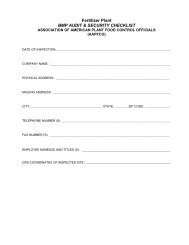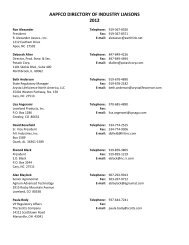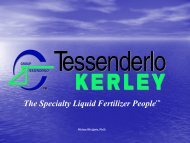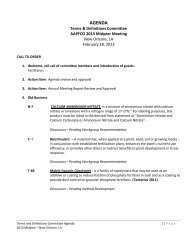download - AAPFCO
download - AAPFCO
download - AAPFCO
You also want an ePaper? Increase the reach of your titles
YUMPU automatically turns print PDFs into web optimized ePapers that Google loves.
Dual Property Microbial Products:The Systemic Acquired Resistance (SAR)andInduced Systemic Resistance (ISR) in plantsAAFCO, August 2009
Outline• Introduction to Dual Property Microbial Products (DPMP)• Current Regulatory landscape for DPMP in Canada• Regulatory requirements under Fertilizers Act andRegulations• Knowledge of plant defence mechanisms includingSAR/ISR.• Delineating gpesticidal and plant growth promotingproperties; Reduced pest pressure conditions• Next steps…• Interdepartmental initiative• Harmonization between regulatory bodies2
Dual Property Microbial Products (DPMP)Products containing non-pathogenic microorganismsthat have both plant growthpromoting and disease control properties.(1) Plant growth promoting properties: enhance plantgrowth and development (symbiosis, increasedsolubilization and uptake of nutrients, release oforganic acids, plant growth regulators etc.)(2) Pesticidal properties: provide protection againstpests/pathogens- direct (e.g. antibiosis, i competition, parasitism) or- indirect (e.g. induction of plant defencemechanisms)3
Current regulatory landscape in CanadaSubjected to regulation by one or more federal regulatory authorities in Canada,depending on the label claims used to describe the benefits or purposeClaims forsupplementaleffects only(enhanced plantgrowth/yield)Registeredunder theFertilizersAct (CFIA)Dual property claims(supplemental effectsand pesticidalproperties)Registration/approvalti from both the CFIA(Fertilizers Act) andPMRA (Pest ControlProducts Act).Claims for pesticidalproperties only (director indirectpest/pathogencontrol)Registered underthe Pest ControlProducts Act [PestManagementRegulatory Agency(PMRA), HealthCanada]4
Regulatory requirements under FertilizersAct and Regulations• All fertilizer and supplement products (including DPMP)imported into and sold in Canada are regulated under theauthority of the federal Fertilizers Act and Regulations• All regulated products must be: Properly LABELLED SAFE for:» plants,» animals,» humans (food, worker/bystander)» the environment EFFICACIOUS when used as directed5
Importance of Knowledge of Mechanismsof Induced Resistance in plants• To make informed decision on claims for supplementalproperties of DPMP• To delineate the pesticidal and supplemental effects ofmicrobial products• To understand the principle behind reduced pestpressure conditions and develop appropriate criteria forefficacy trials, in order to evaluate the actualsupplemental effects6
Induced resistance in plantsSusceptible plant(rr genes)Virulent micro-organism(VIR genes)Virulent micro-organism(VIR genes)- Establishment of disease;- Expression of disease symptoms;- Reduction in growth/yield; and/or- Death of the plantResistant plant(RR or Rr genes)Avirulent microorganism(AVR genes)Avirulent microorganism(AVR genes)Localresponse(necrosis)Induced resistanceLocalresponse7
Downstream effects of Induced resistanceThe cascade of induced plant defence responses:• Reactive oxygen species (ROS) burst• Hypersensitive Response (HR)-necrosis• Induced defence proteins and metabolites• Localized cell death at the initial infection site– necrosis– structural changes to the cell wall (formation of corklayers, tylosis, papilla or by deposition and crosslinking ofpolysaccharides, proteins, glycoproteins or insolublephenolics)– Accumulation of antimicrobial compounds such as thephytoalexins (isoflavonoids and terpenoids)• Systemic acquired resistance (SAR) and Induced systemicResistance (ISR)8
Systemic acquired resistance (SAR)• Non-specific systemic resistance against a broadspectrum of pathogens in distant, uninfected plantparts• SAR mediated d through h salicylic acid (SA)-dependentd signalling pathway results in the induction ofpathogenesis-related proteins (PR proteins)• SA-independent signalling pathways mediatedthrough jasmonic acid and ethylene, results in theaccumulation of protein inhibitors and plant defensins9
Induced systemic resistance (ISR)Local resistance againstpathogensInduced systemic resistanceNonpathogenic, plant growthpromoting rhizobacteria (PGPR)- ISR is mediated through Jasmonic acid (JA) and ethylenedependentsignalling pathway- ISR is highly host-specific specific (i.e. certain PGPR strains can elicitISR only in certain plant species and genotypes)- Downstream effects of ISR- Accumulation of phytoalexin,phenolic compounds and lignins, increase in the levels of PRproteins, peroxidases and phenylalanine ammonia lyase (PAL)10
Cross-talk between plant defence signallingpathways[Adapted from “A novel signalling pathway controlling induced systemic resistance in Arabidopsis”, Pieterse et al., 1998]11
Elicitors of plant defence responses-SAR- Several signal molecules or “elicitors” from pathogens orfrom hosts can trigger defence responses in plants.- Fungal cell wall elicitors have been well characterizedand include oligosaccharides, glycoproteins, peptidesand lipids.(E.g., β-1,3–1,6 glucans, xyloglucans, oligogalacturonides; and chitinderivedoligomers like Chitosans)- Plant-based elicitors(E.g., oligogalacturonic acids (OGA)- Synthetic compounds(E.g., Acetylsalicylic acid (aspirin), benzo(1,2,3)thiadiazole-7-carbothioic acid S-methyl ester (BTH)
Role of Elicitors in plant defenceFor example, “Chitosan” (deacetylated derivative ofchitin),- a major component of many fungal cell walls- Synthesis s of callose (local response)se)- Elicitation of hydrogen peroxide (H 2 O 2 ) production- Enhanced transcription/translation of plant defensegenes encoding pathogenesis-related proteins (PRs)and phytoalexins- Release of linolenic acid from membranes and itsconversion to the signalling molecule: jasmonic acid(JA)
Plant hormones during gplant defenceWhen plants encounter a pest or pathogen:- defence signals are activated to restrict pathogeninvasion- several plant hormones such as brassinosteroids (BL),auxins, gibberellins (GA), cytokinins (CK), and abscisicacid (ABA) play roles in plant responses to pest orpathogen attackInduction of plant growth promotion may occurwhen plant defence responses are activated.14
Criteria for evaluating the supplementaleffects of DPMP- Reduced pest pressure conditions- Field vs. controlled conditions trials- Use of pesticides for pest/pathogen control (specific vsbroad spectrum chemicals)- Sensitivity of the active ingredients to pesticides- Monitoring for severity and frequency of diseasesymptoms during reduced pest pressure- Proof of concept data to demonstrate the supplemental(growth promoting) effect of such products16
Next StepsThe Crop Inputs Division, CFIA is in the process ofdeveloping policies for regulating DPMP.* Literature review on SAR/ISR (prepared andcirculated to stakeholders -2008/09* Discussion document highlighting the criteria forreduced pest pressure trial conditions –underconsultation through ad hoc meetings- 2009/10• Interdepartmental working group to involve PMRA• To share best pest management practices• To discuss the possibility of joint registrationprocess for DPMPs17
CONTACTS AND INFORMATIONIf you wish to obtain more information on theregulation of DPMP in Canada please feel free tocontact us:Fertilizer Safety Office and Fertilizer SectionCrop Inputs DivisionCanadian Food Inspection Agency59, Camelot drive, OttawaOntario K1A 0Y9Tel# (613) 221-7512Fax# (613) 228-4552Email: fertilizer@inspection.gc.ca18









